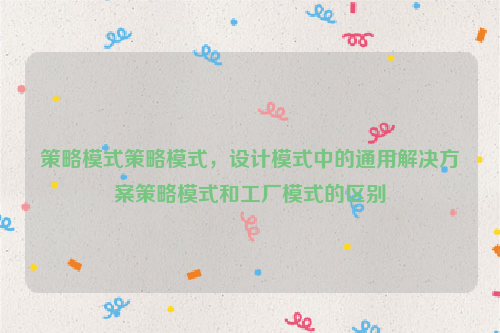在软件开发中,我们经常会遇到一些需要根据不同条件选择不同行为的场景,这时,我们可以使用策略模式来解决这个问题,策略模式是一种行为型设计模式,它将一组行为封装到一系列的策略类中,从而使得这些行为可以相互替换,策略模式让算法独立于使用它的客户端。
策略模式的主要角色有以下几个:

1、抽象策略(Strategy):定义所有支持的策略接口。
2、具体策略(ConcreteStrategy):实现抽象策略的具体策略类。
3、上下文(Context):持有一个策略类的引用,提供一个方法来设置策略类。
4、客户端(Client):使用上下文对象来调用具体策略的方法。
下面我们通过一个简单的例子来说明策略模式的使用,假设我们需要根据不同的天气情况来决定穿什么衣服,我们可以将这个决策过程分为两个策略:晴天穿长袖衬衫,阴天穿外套,雨天穿雨衣。
我们定义一个抽象策略接口:
from abc import ABC, abstractmethod
class ClothesStrategy(ABC):
@abstractmethod
def choose_clothes(self):
pass我们实现具体的策略类:
class ShortSleeveShirtStrategy(ClothesStrategy):
def choose_clothes(self):
return "晴天穿短袖衬衫"
class OvercoatStrategy(ClothesStrategy):
def choose_clothes(self):
return "阴天穿外套"
class RaincoatStrategy(ClothesStrategy):
def choose_clothes(self):
return "雨天穿雨衣"我们定义一个上下文类,用于维护一个策略类的引用:
class WeatherContext:
def __init__(self, strategy: ClothesStrategy):
self._strategy = strategy
def set_strategy(self, strategy: ClothesStrategy):
self._strategy = strategy
def get_strategy(self):
return self._strategy我们创建一个客户端来调用具体策略的方法:
def main():
sunny_context = WeatherContext(ShortSleeveShirtStrategy())
print(sunny_context.get_strategy().choose_clothes()) # 输出:晴天穿短袖衬衫
overcast_context = WeatherContext(OvercoatStrategy())
print(overcast_context.get_strategy().choose_clothes()) # 输出:阴天穿外套
rainy_context = WeatherContext(RaincoatStrategy())
print(rainy_context.get_strategy().choose_clothes()) # 输出:雨天穿雨衣通过以上示例,我们可以看到策略模式可以帮助我们在不修改客户端代码的情况下,轻松地切换不同的行为,这对于提高代码的可扩展性和可维护性非常有帮助。





